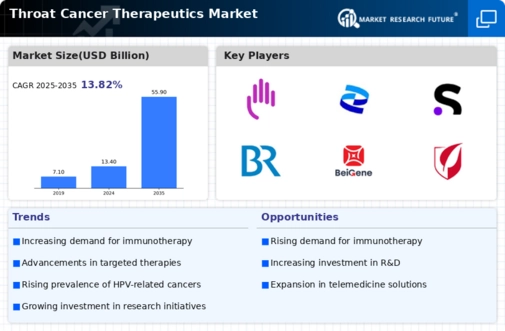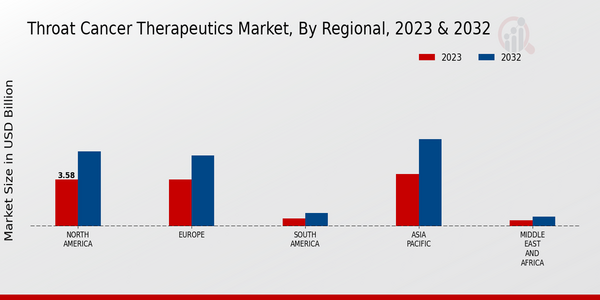Market Growth Projections
The Global Throat Cancer Therapeutics Market Industry is projected to experience substantial growth over the coming years. The market is expected to reach a valuation of 13.4 USD Billion in 2024 and is anticipated to expand to 55.9 USD Billion by 2035. This remarkable growth trajectory indicates a robust compound annual growth rate (CAGR) of 13.82% from 2025 to 2035. Such projections reflect the increasing demand for effective throat cancer therapies, driven by rising incidence rates, advancements in treatment modalities, and growing awareness among healthcare professionals and patients alike. The market's expansion is indicative of the ongoing efforts to improve patient outcomes and enhance therapeutic options.
Rising Incidence of Throat Cancer
The Global Throat Cancer Therapeutics Market Industry is experiencing growth due to the increasing incidence of throat cancer worldwide. According to health statistics, the prevalence of throat cancer has been rising, particularly in regions with high tobacco and alcohol consumption. This trend necessitates the development of effective therapeutic options, thereby driving market demand. As the global population ages, the number of throat cancer cases is projected to increase, further emphasizing the need for innovative treatments. This rising incidence is expected to contribute significantly to the market's valuation, which is anticipated to reach 13.4 USD Billion in 2024.
Advancements in Treatment Modalities
Innovations in treatment modalities are significantly influencing the Global Throat Cancer Therapeutics Market Industry. The introduction of targeted therapies and immunotherapies has transformed the therapeutic landscape, offering patients more effective and less toxic options. For instance, the development of monoclonal antibodies and checkpoint inhibitors has shown promising results in clinical trials, leading to improved survival rates. These advancements not only enhance treatment efficacy but also expand the market by attracting investments in research and development. As a result, the market is projected to grow at a CAGR of 13.82% from 2025 to 2035, reflecting the increasing adoption of these novel therapies.
Growing Awareness and Screening Programs
The Global Throat Cancer Therapeutics Market Industry benefits from heightened awareness and screening initiatives aimed at early detection of throat cancer. Governments and health organizations are implementing campaigns to educate the public about risk factors and symptoms, leading to earlier diagnoses. Enhanced screening programs are crucial in identifying throat cancer at more treatable stages, thereby improving patient outcomes. This proactive approach not only increases the demand for therapeutic interventions but also encourages pharmaceutical companies to invest in developing new treatments. As awareness continues to grow, the market is likely to expand, aligning with the projected market value of 55.9 USD Billion by 2035.
Regulatory Support and Approval Processes
Regulatory support plays a crucial role in shaping the Global Throat Cancer Therapeutics Market Industry. Streamlined approval processes for new therapies can significantly reduce the time it takes for innovative treatments to reach the market. Regulatory agencies are increasingly recognizing the need for expedited pathways for promising therapies, particularly those addressing critical unmet needs in throat cancer treatment. This supportive environment encourages pharmaceutical companies to invest in developing new drugs, knowing that they may receive quicker approvals. Consequently, this trend is likely to enhance market growth, as more therapeutic options become available to patients in need.
Increasing Investment in Research and Development
Investment in research and development is a key driver of the Global Throat Cancer Therapeutics Market Industry. Pharmaceutical companies are allocating substantial resources to discover and develop novel therapeutic agents, particularly in the realm of personalized medicine. This focus on R&D is essential for addressing the unmet medical needs of throat cancer patients, as existing treatments may not be effective for all subtypes of the disease. Collaborative efforts between academia and industry are fostering innovation, leading to the emergence of new therapies. As a result, the market is poised for growth, with a projected CAGR of 13.82% from 2025 to 2035, reflecting the ongoing commitment to advancing treatment options.












